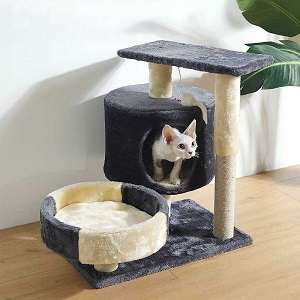Cat enthusiasts understand the importance of providing their feline companions with enriching environments that cater to their instincts and preferences. In this pursuit, cat caves and cat trees emerge as popular choices, each offering distinct features and benefits.
This article delves into the differences between cat caves and cat trees, shedding light on their unique qualities and the roles they play in enhancing a cat’s life.

Distinguishing Aspects
In this part, we will explore distinguishing cat caves from cat trees in 6 aspects, including structure and form, purpose and function, social interaction, space considerations, appeal to instincts,and individual preferences.
1. Structure and Form
Cat Caves
Cat caves, also known as cat beds or hideaways, are enclosed and cozy spaces designed to mimic the feeling of a shelter. They are often made of soft materials and offer a private, secluded spot where cats can rest and feel secure.
Cat Trees
Cat trees, on the other hand, are multi-level structures that incorporate platforms, perches, scratching posts, and sometimes hiding spots. They mimic the environment of a tree, offering cats opportunities to climb, scratch, perch, and survey their surroundings.
2. Purpose and Function
Cat Caves
The primary purpose of a cat cave is to provide a safe, comfortable, and enclosed space where cats can relax, sleep, and feel protected. Cat caves are particularly beneficial for shy or introverted cats seeking a place of solitude.
Cat Trees
Cat trees are designed with various elements that cater to a cat’s natural behaviors. They provide opportunities for climbing, scratching, jumping, and perching, allowing cats to exercise, explore, and satisfy their curiosity.
3. Social Interaction
Cat Caves
While cat caves offer a sense of security, they are not typically designed for extensive social interactions. They provide a personal space where cats can retreat to when they desire solitude or a break from social interactions.
Cat Trees
Cat trees often encourage social interactions among multiple cats or between cats and their human companions. The different levels and perches allow cats to interact with each other, engage in play, and observe their environment from various vantage points.
4. Space Considerations
Cat Caves
Cat caves are relatively compact and can easily fit into smaller living spaces. They are ideal for apartments or homes with limited rooms.
Cat Trees
Cat trees are larger structures that require more space. They are suitable for larger living areas where there’s ample room for cats to climb and explore without hindrance.
5. Appeal to Instincts
Cat Caves
Cat caves primarily cater to a cat’s instinct for seeking shelter and safety. They replicate the feeling of a den, which appeals to a cat’s need for privacy and security.
Cat Trees
Cat trees tap into a variety of instincts, including climbing, scratching, and perching. They satisfy a cat’s natural desire to explore vertical spaces and observe their territory from a higher vantage point.
6. Individual Preferences
Ultimately, whether a cat prefers a cat cave or a cat tree depends on its personality, habits, and preferences. Some cats may gravitate towards the coziness of a cave, while others may thrive on the engaging activities offered by a tree.

Conclusion
Both cat caves and cat trees serve valuable roles in a cat’s environment, but they cater to different needs and preferences. While cat caves offer a quiet retreat for relaxation and privacy, cat trees provide a dynamic playground that stimulates physical activity and social interaction.
By understanding the distinctions between these two options, cat owners can make informed choices that best align with their feline companion’s personality and lifestyle.
 Abraham
Abraham